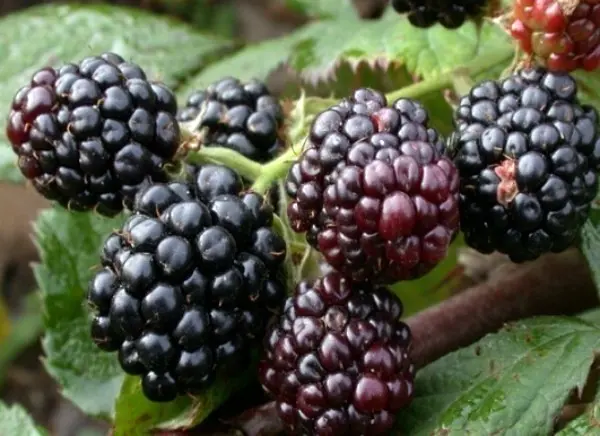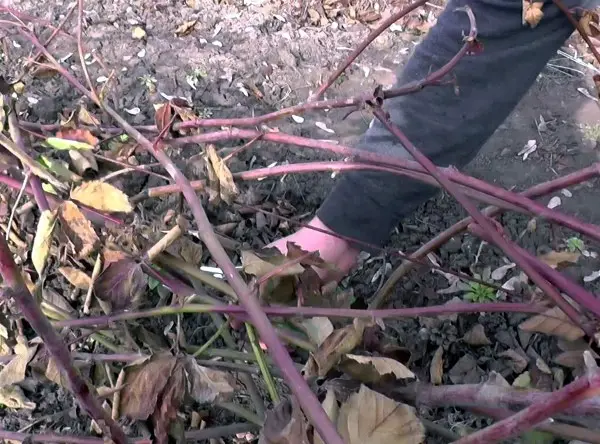Contents
Although the description of the blackberry makes it a close relative of the well-known raspberry, in Europe the planting and cultivation of berries on an industrial scale is not yet practiced. In our country, blackberries, as a rule, grow in the wild, and only sometimes in a few gardens of summer residents who have a weakness for a variety of garden innovations. The most popular variety of such a crop is the Thornfree blackberry, which will be discussed in this article.
Variety description
Blackberry of this variety is a culture with creeping or erect shoots, with a two-year above-ground part. In the first year of the life of the bush, he actively builds up young shoots, on which the future crop is laid. Next year, inflorescences will appear on these shoots, berries will begin to ripen. After fruiting ends in the fall, the shoots die off for the winter, making room for new ones. The root system gives rise to new young shoots that replace dead ones. Thus, every year there are 2 types of branches on a blackberry bush: those that grow and those that bear fruit.
Blackberry bushes are covered with lush dark green foliage that turns crimson in winter. One of the characteristic features of this variety is its large, pale pink flowers.

Advantages and disadvantages
An adult blackberry bush of this variety can reach 3–4 m. One of the characteristic features, without which it is impossible to make a reliable description of the Thornfree variety, is the absence of thorns on the branches. Thanks to this, pruning and caring for the bush is greatly simplified. There is another variety close to “Thornfree” – this is the “Evergreen Thornless” blackberry, which is also not equipped with thorns.
The growing popularity among domestic summer residents, which the Thornfree variety boasts, as well as Evergreen Thornless, is due to the excellent taste of the berry and the unpretentiousness of the plant:
- The variety is drought-resistant – the bush is able to put up with a lack of moisture for a long time.
- Blackberry variety “Thornfree” has a high yield. If agricultural technology is not intensive enough, the bush bears fruit simply abundantly, but if the plant is fertilized regularly, then up to 30 kg of berries per season can be harvested from one plant.
- Good winter hardiness – plants are able to survive even a cold winter, with temperatures dropping to -20 degrees.
- Variety “Thornfree” has a high threshold of disease resistance.
- The complete absence of thorns on the branches.

The only drawback of the variety is the poor resistance of the berries to transportation and poor keeping quality during long-term storage (unlike Thornfree, the Evergreen Thornless variety tolerates long journeys well, without being prone to loss of presentation).
Care and reproduction
Blackberry bushes are planted as follows: a hole is dug up to half a meter deep, a nutrient mixture of potassium, humus and superphosphate is placed inside. The earth in the hole is mixed to prevent contact of the seedling roots with fertilizers. The young plant is installed in the hole, sprinkled abundantly with earth and watered. That’s it, landing completed!
Another mandatory point is that the pruning of the seedling should take place in such a way that shoots no longer than 30 cm remain.

The installation of trellises will greatly facilitate the care of the blackberry bush. To do this, in the place where the blackberry was planted, supports up to 2 m high are installed. A thread or wire is pulled between them, to which the growing side shoots are tied, of course, if last year’s shoots are pruned.
With the advent of spring, the bush requires top dressing: organic fertilizers are applied, the bushes are mulched. Before the ovary is formed, you can fertilize the bushes with urea or a potassium complex. When the berries begin to ripen, the blackberry needs watering (in the hot season, the blackberry fruits are sintered without having time to ripen). It is noteworthy that the flowering of the Evergreen Thornless blackberry begins a week later, respectively, and the fruits will appear later.
Care for blackberry bushes consists, in addition to top dressing, in regular loosening of the soil and timely removal of weeds.

Another mandatory step in the care of blackberries is pruning. They form a bush in the usual bush way, tying the regrown lashes to the supports, but fan molding can also be used – in this case, the lashes are laid evenly on two sides by weaving to facilitate the care of the soil around the roots. If a short pruning is used, then the excess length of the stem is cut with shears to stimulate the development of lateral branches. In the case where intensive side pruning is practiced, there is no need to pinch the tops.
In autumn, it is imperative to completely free the bush from all fruit-bearing branches and cover it for the winter, after tying new shoots to the trellises.
To shelter blackberries from frost, ordinary straw is often used. In this form, the bushes calmly survive the winter.
If the plants are provided with decent care, they are healthy and strong, pruning is carried out on time, then such bushes can be used for reproduction.

The Thornfree variety, like Evergreen Thornless, is propagated by root cuttings. At the very beginning of spring, you need to dig out small pieces of roots and plant them to a depth of 7–10 cm in a permanent place.
For propagation of creeping varieties, the method of rooting tops or cuttings is used. It is not difficult to root the tops: in early autumn, the end of the shoot is bent to the soil and placed in a small hole, digging and fixing the branch on this segment. In this form, the wintering of the plant takes place, it does not require any additional care, and with the advent of the next season, the sprout should be sufficiently fixed. A bush with a rooted top should be covered in the same way as other blackberries.
Collection
The period of ripening of berries in blackberries “Thornfree” falls on the second half of July – August (while “Evergreen Thornless” bears fruit even in autumn). Fruits that need to be stored for the winter are harvested in dry weather, preferably in the early morning. Freezing is the best way for long-term storage: in this state, the berries will lie quietly all winter without losing their qualities.
Video “Blackberry Thornfree”
We invite you to watch a short video review of the Thornfree blackberry variety from the specialists of the Greensad garden center.









